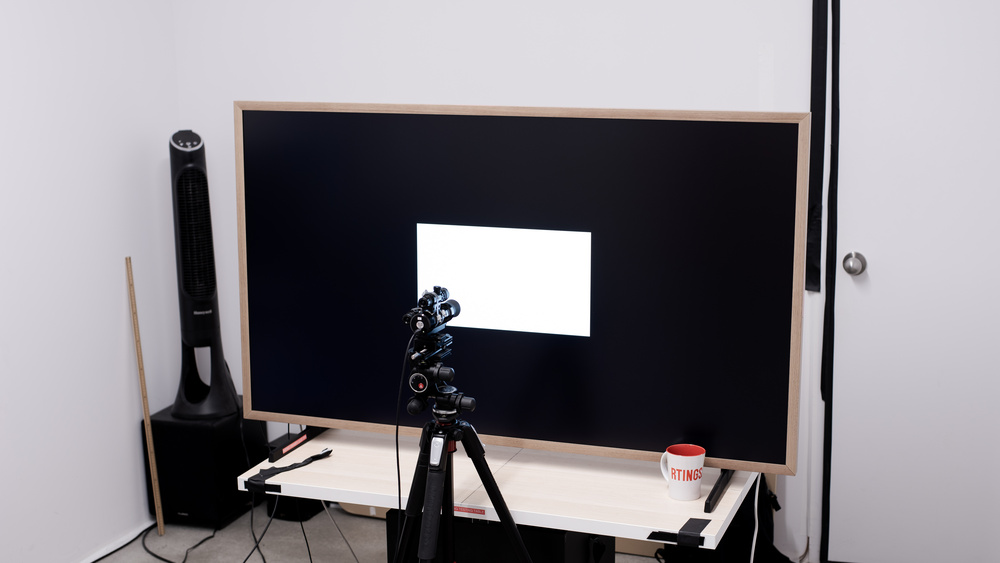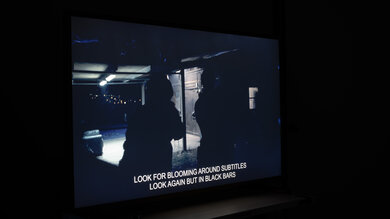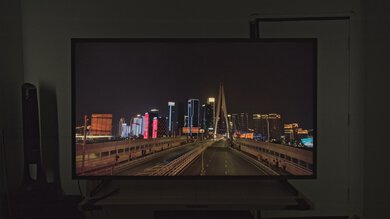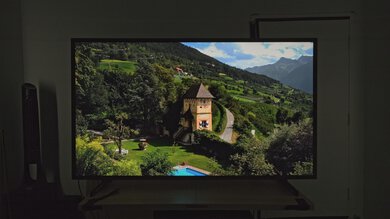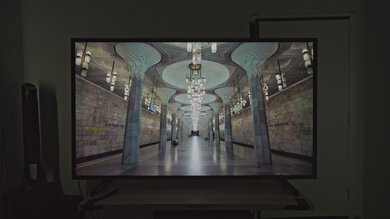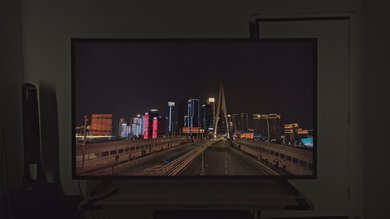The Hisense CanvasTV QLED 2024 is a mid-range 4k TV in Hisense's 2024 lineup with a unique twist: it comes with a wood-like frame alongside a series of included landscapes and paintings and is meant to double as an art piece in your home when wall-mounted. It uses a KSF phosphor coating, designed to deliver more vibrant and lifelike colors than traditional LED TVs. Unlike most TVs on the market, it uses a matte screen coating that is meant to significantly reduce reflections in a bright room. It has four HDMI ports, two of which carry HDMI 2.1 bandwidth with support for 4k @ 144Hz and 1080p @ 240Hz gaming. The TV supports HDR10+ and Dolby Vision and passes through advanced audio formats from Dolby and DTS through its eARC port. It comes in two sizes: 55 and 65 inches.
Our Verdict
The Hisense Canvas TV is a decent TV overall. It delivers a very good gaming experience thanks to its low input lag, and it even comes with a few nice gaming features like VRR support and 4k @ 144Hz/1080p @ 240Hz capabilities. Due to its high SDR brightness and good reflection handling, it looks good in a well-lit room when watching SDR content. It's alright for HDR content, but its contrast is sub-par, and its HDR brightness is mediocre, so it doesn't offer an impactful HDR experience. Finally, the TV's image degrades at an angle, so it's not a good choice if you have a wide seating arrangement.
-
Good reflection handling with glare from direct sources of light.
-
Solid image processing.
-
Wide selection of streaming apps.
-
Image quality degrades rapidly at an angle.
-
Smudges glare from ambient lights across the screen instead of reducing its size.
-
Terrible pre-calibration accuracy in SDR.
The Hisense Canvas TV is a satisfactory TV for watching shows in a bright room. Its SDR brightness is great, and its reflection handling is good, so it offers a pleasant viewing experience overall. Unfortunately, its matte coating diffuses glare from ambient lighting across the panel instead of just reducing its size, impacting image quality in the process due to lower perceived contrast. The smart interface is fast and easy to use, and there's a great selection of streaming apps to easily find your favorite shows. It's not as well-suited for a wide seating arrangement, as the image degrades rapidly when viewed at an angle.
-
Good reflection handling with glare from direct sources of light.
-
Solid image processing.
-
Wide selection of streaming apps.
-
Image quality degrades rapidly at an angle.
-
Smudges glare from ambient lights across the screen instead of reducing its size.
-
Terrible pre-calibration accuracy in SDR.
The Hisense Canvas TV is a decent TV for watching sports in a bright room. It's very bright when watching SDR content, and its reflection handling performs well when dealing with direct sources of light, such as from lights and windows placed directly opposite the TV. It doesn't perform nearly as well when dealing with glare from ambient sources of light, as it smudges them across the screen, reducing the TV's perceived contrast in the process. It has a great response time, so fast motion in sports looks crisp, with little motion blur. Unfortunately, it's not a good choice for a wide seating arrangement, as the image degrades rapidly when viewed at an angle.
-
Good reflection handling with glare from direct sources of light.
-
Great response time with little motion blur behind fast moving objects.
-
Solid image processing.
-
Image quality degrades rapidly at an angle.
-
Smudges glare from ambient lights across the screen instead of reducing its size.
-
Terrible pre-calibration accuracy in SDR.
The Hisense Canvas TV delivers a very good gaming experience. It has low input lag and a great response time, ensuring a smooth, responsive gaming experience with little delay in your inputs. It also supports some advanced gaming features like VRR to reduce tearing, as well as 4k @ 144Hz and 1080p @ 240Hz on two of its HDMI ports, although VRR doesn't work properly with the latter. It's bright enough in SDR to look nice in bright rooms, especially if you can avoid glare from ambient sources of light, as its reflection handling smudges those across the screen, lowering picture quality.
-
Low input lag.
-
Good reflection handling with glare from direct sources of light.
-
Great response time with little motion blur behind fast moving objects.
-
4k @ 144Hz and 1080p @ 240Hz support, although VRR doesn't work with the latter.
-
Smudges glare from ambient lights across the screen instead of reducing its size.
-
Terrible pre-calibration accuracy in SDR.
The Hisense Canvas TV is alright for watching movies in a dark room, but mostly due to its solid image processing and judder removal capabilities. Otherwise, its HDR brightness is mediocre, so highlights don't pop. Its contrast ratio is sub-par due to lacking a local dimming feature, so blacks are raised whenever bright highlights are on screen. Furthermore, the TV's pre-calibration accuracy in SDR is terrible, leading to noticeably off colors; you'll need to have this TV calibrated if you care about image accuracy in SDR movies. Thankfully, HDR content is much more accurate.
-
Impressive wide color gamut.
-
Supports both Dolby Vision and HDR10+, and supports DTS through eARC.
-
Solid image processing.
-
Wide selection of streaming apps.
-
No local dimming feature to improve contrast.
-
Low peak brightness in HDR.
-
Smudges glare from ambient lights across the screen instead of reducing its size.
-
Terrible pre-calibration accuracy in SDR.
The Hisense Canvas TV delivers a very good gaming experience, but HDR adds little due to its mediocre HDR peak brightness. Plus, it lacks a local dimming feature, so bright highlights in games don't stand out at all, and everything looks flat overall. Still, even though it's not quite bright enough to make its colors pop in brighter scenes, it does have an impressive color gamut in HDR, so games look vibrant and realistic. It also has a low input lag and a quick response time, resulting in smooth motion and a responsive feel.
-
Low input lag.
-
Impressive wide color gamut.
-
Great response time with little motion blur behind fast moving objects.
-
4k @ 144Hz and 1080p @ 240Hz support, although VRR doesn't work with the latter.
-
No local dimming feature to improve contrast.
-
Low peak brightness in HDR.
-
Smudges glare from ambient lights across the screen instead of reducing its size.
The Hisense Canvas TV is great for use as a PC monitor, although it does have some inconveniences for that usage, and it looks a bit strange when used as a PC monitor due to its art-style design. Its viewing angle is narrow, resulting in the screen's sides appearing non-uniform if you're sitting close to the screen. Its reflection handling is good, but it struggles with glare coming from ambient light sources due to smudging them across the screen. Still, it's bright enough in SDR to have a pleasant experience in well-lit offices. Plus, it has very low input lag and a quick response time, leading to a responsive experience overall. The TV displays chroma 4:4:4 properly, but the TV uses a BGR subpixel layout that impacts the text clarity, although not everyone will be bothered by this.
-
Low input lag.
-
Chroma 4:4:4 is displayed properly for clear text from a PC.
-
Good reflection handling with glare from direct sources of light.
-
Great response time with little motion blur behind fast moving objects.
-
Image quality degrades rapidly at an angle.
-
Smudges glare from ambient lights across the screen instead of reducing its size.
-
Terrible pre-calibration accuracy in SDR.
- 7.3 Mixed Usage
- 7.2 TV Shows
- 7.4 Sports
- 7.8 Video Games
- 6.9 HDR Movies
- 7.8 HDR Gaming
- 8.1 PC Monitor
- Updated Sep 25, 2024: Review published.
- Updated Sep 20, 2024: Early access published.
- Updated Sep 12, 2024: Our testers have started testing this product.
- Updated Aug 28, 2024: The product has arrived in our lab, and our testers will start evaluating it soon.
- Updated Aug 15, 2024: We've purchased the product and are waiting for it to arrive in our lab.
Differences Between Sizes And Variants
We tested the 65-inch Hisense Canvas TV, and our results are also valid for the 55-inch model. While the TV is currently only being sold in North America, there are plans for a future European release.
| Size | US Model | HDMI Ports |
|---|---|---|
| 55" | 55S7N | 4 |
| 65" | 65S7N | 4 |
The unit we tested was manufactured in June 2024, and you can see our unit's label.
Compared To Other TVs
The Hisense Canvas TV is a rather unique TV, with only the Samsung The Frame 2024 QLED offering something similar: a TV that looks more like a painting than a TV. The Hisense comes with a wood-like frame, a matte coating, and a selection of included landscapes, all to make the TV look like a piece of art decor. It still offers decent performance overall, and comes with a surprising array of gaming features. Still, it lacks a few core essentials, such as local dimming to improve its contrast, and its pre-calibration accuracy is terrible in SDR. Ultimately, if you're specifically looking for a TV that look like this your only alternative is the aforementioned Samsung, and while it does perform better than the Hisense, it comes at a higher cost. If you're mostly interested in performance rather than looks, than you'd be better off getting the cheaper, and far better, Hisense U7N instead.
See our recommendations for the best 4k TVs, the best budget TVs, and the best 4k gaming TVs.
The Samsung The Frame 2024 QLED is better than the Hisense CanvasTV QLED 2024, but the Samsung is also noticeably more expensive. Still, the Samsung has better contrast and is brighter in HDR, has a wider viewing angle, better reflections handling, and is also much more accurate pre-calibration than the Hisense is. The Hisense does have the edge for PC gaming due to its 4k @ 144Hz support, and has Dolby Vision with advanced DTS audio format support, but overall the Samsung is definitely the better performer overall.
The Hisense U7N is vastly better than the Hisense CanvasTV QLED 2024. The Canvas has a unique look, with its wood-like frame and matte coating, making it look like an art piece in your home. But, if you're looking for image quality, the U7N outperforms it in every metric: contrast, HDR and SDR brightness, colors, and gaming performance. Plus, the U7N is typically sold for a cheaper price than the Canvas. Ultimately, these two products are not aimed at the same market, as the U7N is a traditional TV, while the Canvas is truly more for those who prefer to add to their home decor and don't care as much about value or performance.
The Hisense CanvasTV QLED 2024 and Hisense A7N deliver similar performance, but in different areas. The cheaper A7N has the better contrast, and is much more accurate in SDR prior to calibration. The Canvas is noticeably brighter in SDR, but way less accurate, so if you prefer SDR pop over accuracy, it's the TV for you. The Canvas also has better image processing, and is the better choice for gamers due to offering full 4k @ 144Hz support, with VRR, while the A7N is limited to 60Hz at all resolutions.
The Hisense CanvasTV QLED 2024 is a bit better than the Samsung DU8000. While the Samsung TV delivers slightly better contrast, the Hisense is noticeably brighter in HDR and SDR, with a wider color gamut, delivering a more impactful viewing experience overall. Unfortunately, the Hisense's pre-calibration SDR accuracy is terrible, so it's not the TV for anyone who likes accurate colors out-of-the-box. The Hisense also has noticeably better image processing and is much better for gaming due to having 4k @ 144Hz support with VRR, alongside a faster response time than the Samsung.
The Hisense CanvasTV QLED 2024 is a bit better than the Hisense A6/A65K, but barely. The A6 has better contrast, but the Canvas is noticeably brighter in SDR and HDR, delivering a more impactful image in most contexts. Unfortunately, the Canvas was also terribly inaccurate in SDR prior to calibration, so it's really not the TV for anyone who cares about color accuracy. Still, Canvas has much better image processing than A6 and is the much more capable gaming TV, with 4k @ 144Hz support and VRR alongside a faster response time than A6.
Test Results
The Hisense Canvas TV uses two feet that support the TV well. They lift the TV about 2.8 inches from the table, so most soundbars fit below the screen, although it'll be a tight fit with chunkier soundbars. It also comes with Hisense's UltraSlim Wall Mount if you prefer to mount the TV to the wall.
The footprint of the 65-inch stand is 44.8" x 14.9".
The back of the TV is plain and made entirely of plastic. Most of the inputs are side-facing and aren't too hard to access when the TV is mounted flush against the wall. The TV has clips on its back to help with cable management, although the cables then dangle directly from the back as there isn't any way to hide them.
The TV has excellent build quality. It's made entirely of plastic, and its frame is made of aluminum, but made to look like wood. The frame blocks part of the first row of pixels, but it's not something you'll notice from a normal viewing distance. When using the stand, there's some wobble from front to back when the TV is pushed, but this doesn't cause any issues. It's well-built overall, and there are no issues with quality control.
This TV doesn't have a local dimming feature, so it can't adjust the backlight of individual zones to brighten up highlights without impacting the rest of the image. But this means that there are no distracting flicker or brightness changes as bright highlights move between zones, as the TV doesn't have any.
Unfortunately, this TV has mediocre peak brightness in HDR. HDR content looks flat and dull overall, as the TV isn't bright enough to bring out specular highlights, and with the lack of a local dimming feature, bright spots don't pop at all.
These measurements are after calibrating the HDR white point with the following settings:
- HDR Picture Mode: Filmmaker Mode
- Brightness: 100
- Contrast: 50
- Black Level: 0
- Dark Detail: Off
- Gamma: ST2084
- Active Contrast: Off
- Dynamic Tone Mapping: Off
- Color Temperature: Warm 1
If you prefer a brighter but less accurate image, here are the results with Dynamic Tone Mapping set to 'On':
- Hallway Lights: 341 cd/m²
- Yellow Skyscraper: 318 cd/m²
- Landscape Pool: 203 cd/m²
Switching to PC/Game Mode doesn't cause a noticeable decrease in overall peak brightness.
These measurements are after calibrating the HDR white point with the following settings:
- HDR Picture Mode: HDR Game
- Brightness: 100
- Contrast: 50
- Black Level: 0
- Dark Detail: Off
- Gamma: ST2084
- Active Contrast: Off
- Dynamic Tone Mapping: Off
- Color Temperature: Warm 1
If you prefer a brighter but less accurate image, here are results with Dynamic Tone Mapping set to 'On':
- Hallway Lights: 339 cd/m²
- Yellow Skyscraper: 311 cd/m²
- Landscape Pool: 204 cd/m²
The Hisense Canvas TV has excellent PQ EOTF tracking. Blacks and near-blacks are slightly raised, while shadows, mid-tones, and highlights are displayed a bit dimmer than intended. There's a gradual roll-off near the TV's peak brightness to retain detail in highlights in all mastered content.
The Hisense Canvas TV has very good SDR brightness and is bright enough to overcome glare in a well-lit room.
These measurements are after calibration with the following settings:
- Picture Mode: Theater Night
- Brightness: 100
- Gamma: 2.2
- Color Temperature: Warm 1
- Active Contrast: Off
The Hisense Canvas TV has an impressive HDR color gamut. It has fantastic coverage of the commonly used DCI-P3 color space, although desaturated colors have some color mapping accuracy issues. The TV has decent coverage of the wider Rec. 2020 color space, but now most colors, regardless of saturation, have color mapping issues, as well as being somewhat off the mark.
The color volume of the Hisense S7N is decent. It displays a satisfactory range of colors at many luminance levels, but it struggles with some dark saturated colors due to its lack of local dimming and satisfactory, but unexceptional, native contrast.
This TV's pre-calibration accuracy is terrible. It's way too cold even on its warmest setting, and blues are extremely overrepresented in almost all shades of gray. Color accuracy fares slightly better but is still poor overall, with all colors having noticeable color mapping issues, more so for cyans and whites, as well as slightly off the mark. Gamma is pretty close to our target of 2.2, but very dark and very bright scenes are too bright.
The TV has outstanding accuracy after calibration. It's not easy to calibrate, however, partly due to how inaccurate it is to start and also due to some settings being too aggressive while others, such as adjusting reds, seem to have almost no effect. Still, after some time, the TV does end up looking very good, with its color temperature now close to the 6,500K target, color accuracy now only showing minor color mapping issues, and blues being only somewhat overrepresented in whites. Gamma is now even closer to our 2.2 target, with only brighter scenes still being too bright.
You can see our full calibration settings here.
The Hisense Canvas TV has decent gray uniformity. The sides of the screen are darker than the middle, and there's some noticeable dirty screen effect towards the middle of the screen. On a very dark or near-black screen, its uniformity is better, but there's some light clouding throughout, and the sides are a bit brighter than the center.
Unfortunately, this TV has inadequate off-angle viewing. The image degrades rapidly as you move off-center, as colors fade rapidly and brightness decreases, causing the image to appear washed out. This makes it a poor choice for a wide seating arrangement.
The overall reflection handling of this TV is generally good, especially when it's dealing with glare from direct sources of light, like from lights or windows placed directly opposite the TV. However, its matte coating diffuses glare from ambient lighting to the point where the resulting smudges reduce the TV's perceived contrast, impacting the TV's picture quality in the process.
The TV has impressive HDR gradient handling. There's noticeable banding in darker blues, but all other colors have minimal or no banding at all.
The Hisense Canvas TV does a good job at upscaling low-resolution content like DVDs or lower-resolution streams. Details are clear enough, but finer details are hard to make out.
Sharpness processing was calibrated with no over-sharpening for low-resolution content, with the following settings:
- Sharpness: 13
- Super Resolution: On
The TV uses a BGR (Blue-Green-Red) subpixel layout instead of the traditional RGB layout. For video or gaming content, this doesn't cause any issues, but for PC monitor use, it can be a problem as it impacts the text clarity, although not everyone will notice this.
The TV uses a KSF phosphor coating to achieve a wide color gamut, as confirmed by the TV's spectral power distribution (SPD).
The TV uses pulse width modulation (PWM) to dim its backlight, which introduces flicker that can bother people who are sensitive to it. That said, this TV flickers at a blistering 19000Hz in all picture modes, which is too fast to be noticed by the human eye.
This TV doesn't have an optional backlight strobing feature, also known as BFI.
The Hisense Canvas TV has an optional motion interpolation feature to improve the clarity of motion. It works a bit better than it usually does on most TVs due to the Hisense dropping frames instead of introducing artifacts. That technique works well in slower scenes, and while it struggles with smoothing out faster scenes, it still results in better results than on many other budget TVs.
Due to the TV's relatively quick response time, there's some minor stutter when watching movies or TV shows, and it's most apparent in slow panning shots.
The Samsung The Frame 2024 automatically removes judder from all sources when watching movies or shows that are in 24p, even if they're in a 60Hz signal, as long as you have the 'Motion Enhancement' settings set to 'Film'.
The Hisense Canvas TV supports all three VRR formats, so it is highly compatible regardless of the source. Unfortunately, with 1080p @ 240Hz and VRR enabled, the TV's built-in frame counter shows 72Hz, and there's bad frame skipping, desaturated colors, and chroma 4:4:4 isn't displayed properly. With VRR disabled, 1080p @ 240Hz works without issues.
This TV has incredibly low input lag when set to PC/Game Mode, which ensures a very responsive gaming experience with very little delay between your actions with your controller or mouse and the action on-screen. In 1080p @ 240Hz, the input lag is 4 ms.
The TV supports all common resolutions up to 4k @ 144Hz on two of its four HDMI ports. Unfortunately, 1080p @ 240Hz only works properly with VRR disabled, as with it enabled, there is obvious frame skipping at refresh rates about 144Hz.
The Hisense Canvas TV is fully compatible with everything the PS5 offers, like 1440p @ 120Hz and 4k @ 120Hz, as well as HDMI Forum VRR. It also supports Auto Low Latency Mode, so you don't have to worry about manually switching to PC/Game Mode to get the lowest input lag.
The Hisense Canvas TV is fully compatible with everything the Xbox Series X|S offers, including 1440p @ 120Hz, 4k @ 120Hz, HDMI Forum VRR, FreeSync Premium Pro, and Dolby Vision gaming. It also supports Auto Low Latency Mode, so you don't have to worry about manually switching to PC/Game Mode to get the lowest input lag.
The TV has HDMI 2.1 bandwidth on HDMI ports 3 and 4, with both supporting up to 4k @ 144Hz. Fortunately, the HDMI 1 port is the eARC port, so you don't lose a high-bandwidth port when you plug a soundbar into the TV. The TV supports all HDR formats.
The TV supports eARC, which lets you pass high-quality, uncompressed audio to a compatible receiver or soundbar through an HDMI cable. It supports all major audio formats, so you don't have to worry about compatibility with external sources.
The Hisense Canvas TV has an okay frequency response. Like most TVs, the bass is pretty much non-existent, and it sounds noticeably more unbalanced at max volume than it does at moderate levels. Still, not everyone notices sound distortion, and the TV gets quite loud, so you could go without a soundbar if you're mostly interested in volume over sound quality.
The TV's distortion performance is inadequate. Distortion is audible near and at max volume, so you need to listen at lower volume levels for no distortion.
The TV has a fantastic selection of apps, so finding your favorite content is easy. You can also cast content from your phone onto the TV or play videos directly from a USB stick.
The TV comes with Hisense's newly designed remote that is backlit. It has buttons for popular streaming services, and you can use the built-in microphone to switch inputs, change apps, search within apps, and ask for the weather and time. Unfortunately, you can't change the settings on the TV using the voice controls.

